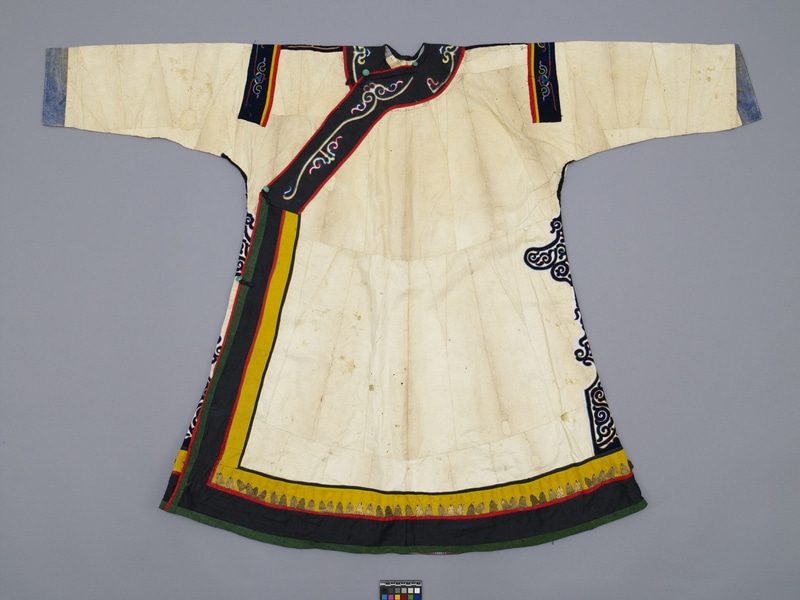Robe Item Number: 2952/1 from the MOA: University of British Columbia



Description
Salmon skin robe with applique embroidery. LIght tan-coloured skin with black fabric edging around the neck and down the side closure. The edging is decorated with a green band and thin red trim. The neck and sides are fastened with small, green plastic, buttons. The yellow band at the hem is decorated with numerous small, flat, bronze or brass metal decorations sewn on. Multi-coloured, geometric appliques on white fabric have been sewn across the entire back and down both sides. The black cowl and shoulders of the coat have silk embroidery in curving patterns. The skin cuffs are painted blue. The inside is lined with flannel and floral patterned fabrics.
History Of Use
Mid-layer wedding dress, or robe. The metal ornamentation along the bottom of the robe hold meaning about the age and status of the wearer. Originally this robe is said to have had coins along the hem, that were removed by the family prior to selling it. The coins represented the family’s wealth and status, which is why they kept them; some of the coins were said to date back to the Song dynasty.
Iconographic Meaning
The coat was made to protect the wearer from spirits. Because of this, it could not be worn with other shamanic regalia. The metal ornaments are meant to make noise in the spiritual realm to prevent possession. Nanai coats have bands along the edges, called frames, in order to lock in embroidered designs, so they don’t escape. Black, blue, and red bands were protective; the yellow in between them represents the sun. The main embroidered design is on the back of coats because that is the wearer’s most vulnerable area. The designs are divided into three levels: sky, land (human realm), and water; there are dragons and fish in each realm, with two dragons along the top row of the back design, and birds on top of them. Birds represent shamans, because shamans use them to travel between realms. The line that splits at the top, dividing into two curls along the collar, is called the “Nanai eye” pattern; it represents the muzzle of a predator (bear or tiger); the predator design also serves to protect the wearer from spirits. The black embroidery along the sides represents three dragons in a 'tree of life' pattern.
Narrative
Made by Durma Sergeevna Khodzher, the mother of the woman who sold it in 1992, Violetta Khodzher. The salmon skin robe itself may date to the early 1900s, and was probably simpler at first with decorations only at the neck and hem. The small embroidery on the back would have been added later, in the 1920-30s. The style of the finished robe is mid 20th century, as earlier robes were all fish skin and later robes were all fabric.
Specific Techniques
The fish skins would have been tanned with pumice or volcanic rock, to make it as white as possible and to remove as many scales as possible. Birch bark would be used as a stencil for the embroidery.
Item History
- Made by Durma Sergeevna Khodzher (Maker) in Khabarovsk, Russia ? between 1900 and 1950
- Collected during 1992
- Owned by Violetta Khodzher
- Owned by Helen O'Brian before April 24, 2012
- Received from Helen O'Brian (Donor) on April 24, 2012
What
- Name
- Robe
- Identification Number
- 2952/1
- Type of Item
- robe
- Material
- salmon skin, cotton fibre, silk fibre, brass metal ?, plastic and paint
- Overall
- height 105.2 cm, width 149.5 cm
Who
- Culture
- Nanai
- Creator
- Durma Sergeevna Khodzher (Maker)
- Previous Owner
- Violetta Khodzher and Helen O'Brian
- Received from
- Helen O'Brian (Donor)
Where
- Holding Institution
- MOA: University of British Columbia
- Made in
- Khabarovsk, Russia ?
When
- Creation Date
- between 1900 and 1950
- Collection Date
- during 1992
- Ownership Date
- before April 24, 2012
- Acquisition Date
- on April 24, 2012
Other
- Item Classes
- textiles
- Condition
- good
- Current Location
- Case 47
- Accession Number
- 2952/0001